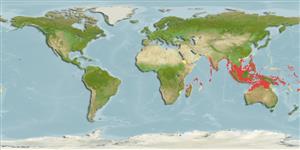>
Callionymiformes (Dragonets) >
Callionymidae (Dragonets)
Etymology: Callionymus: Greek, kallion, comparative of kallos = beautiful + Greek, onyma = name; with a better name.
More on author: Day.
Environment: milieu / climate zone / depth range / distribution range
Écologie
marin; saumâtre démersal. Tropical
Indo-Pacific: Indian subcontinent to Viet Nam. Common in the Mekong delta and probably found in Cambodia.
Taille / Poids / Âge
Maturity: Lm ? range ? - ? cm
Max length : 7.0 cm TL mâle / non sexé; (Ref. 12693)
Épines dorsales (Total) : 4; Rayons mous dorsaux (Total) : 10; Rayons mous anaux: 9. Sandy yellow, ventrally lighter. First dorsal fin with a black blotch basally on third membrane. Second dorsal fin, caudal fin, pectoral and pelvic fins spotted with brown. Anal fin white. First dorsal fin lower than second dorsal fin. First spine of first dorsal fin shorter than second spine. Anal fin pale. Second dorsal fin without white bands (Ref 42832).
Occurs on the bottom in the lower courses of rivers. Feeds on worms, zooplankton and phytoplankton. Occasionally marketed fresh (Ref. 12693).
Life cycle and mating behavior
Maturité | Reproduction | Frai | Œufs | Fécondité | Larves
Rainboth, W.J., 1996. Fishes of the Cambodian Mekong. FAO species identification field guide for fishery purposes. FAO, Rome, 265 p. (Ref. 12693)
Statut dans la liste rouge de l'IUCN (Ref. 130435: Version 2024-2)
Menace pour l'homme
Harmless
Utilisations par l'homme
Pêcheries: intérêt commercial mineur
Outils
Articles particuliers
Télécharger en XML
Sources Internet
Estimates based on models
Preferred temperature (Ref.
123201): 23.9 - 28.6, mean 27.4 °C (based on 1025 cells).
Phylogenetic diversity index (Ref.
82804): PD
50 = 0.5000 [Uniqueness, from 0.5 = low to 2.0 = high].
Bayesian length-weight: a=0.00891 (0.00410 - 0.01937), b=2.78 (2.60 - 2.96), in cm total length, based on LWR estimates for this Genus-body shape (Ref.
93245).
Niveau trophique (Ref.
69278): 2.8 ±0.28 se; based on food items.
Résilience (Ref.
120179): Haut, temps minimum de doublement de population inférieur à 15 mois (Preliminary K or Fecundity.).
Fishing Vulnerability (Ref.
59153): Low vulnerability (10 of 100).
